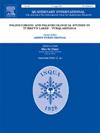A pollen-based reconstruction of middle to late holocene precipitation dynamics in Anyang archaeological area, Central Plains, China
Abstract
In the context of global warming, the dynamics of East Asian Summer Monsoon (EASM) are of great significance for predicting future climate change. The variations of humidity indicated by various climate proxies in Central China are controversial. This study relies on pollen data retrieved from lacustrine sediment at the Anshang site in Anyang archaeological area, Central Plains of China to quantitatively reconstruct the change in PANN (mean annual precipitation). The results show that the region experienced three distinct dry-wet intervals during the ∼8.54 to ∼3.26 cal ka BP: the earlier portion of the mid-Holocene (∼8.5–∼6.0 cal ka BP) witnessed the higher PANN; the latter portion of the mid-Holocene (∼6.0–∼3.6 cal ka BP) enjoyed the highest PANN of the past ∼8500 years with a noticeable cold and dry event occurred around 4.2 cal ka BP; the late Holocene (∼3.6–∼3.2 cal ka BP) experienced the lower PANN. Periodic analysis on pollen-based precipitation further reveals ∼500-year and ∼800-year cycles, matching well with regional climate records. Our regional comparison suggests that the Central Plains of China shared similar climatic controls with the southern region of China during the ∼8.54 to ∼3.26 cal ka BP. Shifts of Western Pacific Subtropical High (WPSH), driven by the ENSO (El Niño-Southern Oscillation) conditions and SST (Sea Surface Temperatures) in the western tropical Pacific, regulated the positioning of the EASM-related rain-belt during ∼8.54 to ∼3.26 cal ka BP. This study provides more reliable variations of humidity in the Central Plains under the influence of the EASM, which is helpful to predict future climate change.

 求助内容:
求助内容: 应助结果提醒方式:
应助结果提醒方式:


